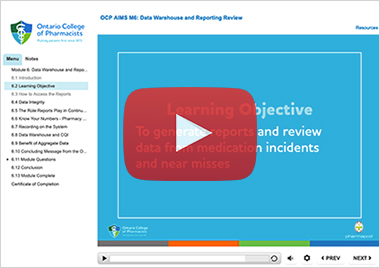Learning from medication safety incidents and near misses is an important part of reducing the risk of patient harm. And one of the best ways to identify and address the root causes of medication errors in a pharmacy is through a process of continuous quality improvement (CQI).
When a medication safety incident occurs, it often has multiple causes—a series of mistakes, oversights or system failures that combine to create risk for a patient. This type of medication error can be visualized with the Swiss cheese model of system accidents[1].
Imagine several slices of Swiss cheese, each representing a different layer of human, technological or system safeguards in your pharmacy. Each layer has holes that reflect the inherent weaknesses in that particular safeguard. Normally, if one hole is penetrated, another slice (or safeguard) stops an error in its tracks. But what if the holes suddenly lined up? Now it’s as though there are no safeguards at all.

The point is, no matter how many protections are put in place, there still exists the potential for a medication incident to occur. This highlights the need for continuous evaluation of a pharmacy’s risk mitigation processes to ensure safeguards and systems are effective and adaptive.
Assurance and Improvement in Medication Safety (AIMS)
To support its mandate to serve and protect the public, the College’s Assurance and Improvement in Medication Safety (AIMS) Program sets expectations for pharmacy professionals regarding the assessment of potential areas of risk in a pharmacy’s workflow, along with tools to assist in extracting actionable learnings from incidents or near misses that do occur.
Through the AIMS Program, registrants have access to their own pharmacy-level medication incident data recorded in the AIMS Pharmapod platform, information that can help practitioners learn from medication incidents and near misses, and better understand why they happen and how they can be prevented. The College has posted an e-learning module on its website to help pharmacy professionals access and understand the information in the data warehouse.
Access the AIMS e-learning module
In addition to the local pharmacy data, the College has developed an interactive tool that allows pharmacy teams and other stakeholders to view aggregate, anonymous medication safety data from across the province to help identify trends or opportunities for continuous quality improvement.
View the interactive data tool
As part of AIMS, all community pharmacies are required to complete the Pharmacy Safety Self-Assessment (PSSA) by December 31, 2021. A pharmacy’s PSSA can only be accessed through the Designated Manager’s Pharmapod account; to login please follow this link: https://www.pharmapodhq.com. The PSSA is an informative quality improvement tool that helps a pharmacy track their efforts to enhance patient safety over time. It can be used to proactively identify areas of potential risk, enabling pharmacy teams to plan improvement activities effectively and demonstrate system improvements. While completing the PSSA is a mandatory component of the AIMS Program, pharmacies are not required to share the PSSA with the College.
Each of these resources—the AIMS Pharmapod platform, the interactive tool and the PSSA—are designed to support pharmacies in meeting the expectations of the Supplemental Standards of Practice (sSOP) and to do so in a consistent and standardized manner across the province.
Quality Indicators
AIMS is just one way for pharmacy professionals to identify potential continuous quality improvement opportunities. Another important source of information comes from community pharmacy quality indicators.
To better understand the impact of pharmacy care on patient outcomes, the College, in partnership with Health Quality Ontario (HQO), established the first set of publicly reported Quality Indicators (QI) for community pharmacy in Canada. These indicators provide a clearer picture of the overall quality of pharmacy care in Ontario and support quality improvement efforts by pharmacy professionals and the College.
The purpose of these indicators is to improve the quality of pharmacy care and to increase transparency about the impact of pharmacy through aggregate level public reporting. Pharmacy professionals, like other healthcare professionals, play an active part in providing quality and safe care to patients while contributing to solutions to address common quality challenges experienced throughout our health system. Safe transitions of care, the opioid crisis, and medication-related hospital visits are just a few examples where pharmacy can play an increasingly valuable role in our health system, while continuing to contribute directly to a patient’s health goals.
The first set of Quality Indicators is posted on the OCP website, measuring the appropriateness of dispensed medications, medication-related hospital visits and transitions of care.
Has your pharmacy made improvements to enhance medication safety?
Share your successes with the College at AIMS@ocpinfo.com















